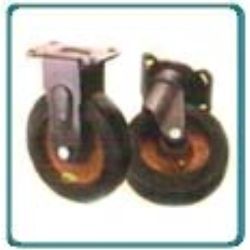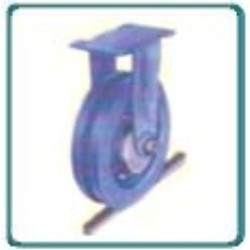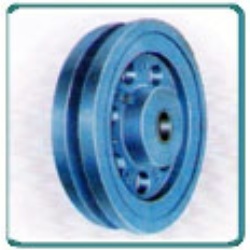V Track
V Track Specification
- Lifting Speed
- Adjustable
- Belt Type
- Rubber / PVC
- Equipment Type
- V Track
- Handle Type
- Ergonomic
- Forklift
- Compatible
- Rotation Type
- Fixed
- Motor Type
- AC / DC
- Wheel Type
- Nylon / PU
- Rack Capacity
- Heavy Duty
- Control System
- Manual / Automatic
- Features
- Precision Engineered
- Condition
- New
- Lifting Capacity
- As per requirement
- Max. Lifting Load
- Up to 2000 kg
- Max. Lifting Height
- Up to 20 feet
- Power Source
- Electric / Manual
- Power Consumption
- Low
- Length of Belt
- Customizable
- Feature
- High Strength, Long Service Life
- Attributes
- Corrosion Resistant, Durable Finish
About V Track
V Track
V Track Wheels are designed to guide equipment by rolling on inverted angle iron track. Elevated track minimizes problems caused by floor debris. The relief groove at the base of the "V" equalizes the load on each face of the angle. Forged Steel V-groove caster wheels minimize wear of the V-groove sides and are best for frequent operation. When not operating on track, the considerable wheel tread on each side of the V-groove allows for use on smooth floors. Our V Track wheels are preferred by our clients due to its smooth functioning, durability and convenience to use.
Features:
- Durable
- Smooth functioning
- Convenient to use
Versatile Customization for Every Application
V Track systems offer flexibility in both design and functionality, with customizable lengths, shapes, colors, and lifting capacities to match the specific needs of various industries. Whether you require a standard V-shaped track or a unique configuration, these tracks can be tailored to logistics, warehousing, or industrial installations. The adjustable lifting speed, ergonomic handles, and wheel options further enhance operational efficiency and safety.
Built to Last with Superior Materials
Manufactured using high-grade mild steel or stainless steel, the V Track undergoes either galvanization or powder coating, resulting in a durable and corrosion-resistant finish. This makes it ideal for harsh working conditions and ensures a prolonged operational life. Its high lifting capacity and robust construction make it suitable for transporting heavy loads, while the low noise design maintains a quieter workspace.
Effortless Installation and Seamless Integration
The V Track features an easy installation process and supports both manual and automatic control systems for seamless integration into existing workflows. Compatible with forklifts and adjustable for different rack and load requirements, it provides a user-friendly interface for quick setup and efficient operation. The systems low power consumption and minimal maintenance needs further contribute to operational savings.
FAQs of V Track:
Q: How is the V Track installed in warehouse or industrial environments?
A: The V Track is engineered for straightforward installation, compatible with most warehouse, logistics, or industrial layouts. Installation typically involves anchoring the modular sections and connecting the control system, which can be either manual or automated. Detailed instructions and support are provided to ensure hassle-free setup.Q: What materials and finishes are available for the V Track?
A: V Tracks are constructed from high-quality mild steel or stainless steel, with finishing choices including galvanized and powder coating. These options deliver excellent corrosion resistance and a durable finish, ensuring long service life even in demanding environments.Q: Where is the V Track most effectively used?
A: The V Track excels in settings such as warehouses, logistics centers, and industrial facilities where efficient material movement, heavy-duty lifting, and low noise operation are critical. Its customizable features allow it to adapt to various operational demands.Q: What is the maximum load and lifting height supported by the V Track?
A: The system is designed to handle loads of up to 2000 kg and can reach lifting heights of up to 20 feet. These specifications can be further customized according to specific requirements for heavy-duty conveying tasks.Q: How does the V Tracks design benefit industrial operations?
A: Engineered for high strength and precision, the V Track offers low noise operation, low power consumption, and ergonomic handling. Its corrosion-resistant construction and durable finish help reduce maintenance costs and downtime, enhancing productivity in industrial environments.Q: What options are available for power and control systems?
A: The V Track supports both electric and manual power sources, along with manual and automatic control systems. This versatility allows integration into diverse operational infrastructures, accommodating both traditional and automated workflows.

Price:
- 50
- 100
- 200
- 250
- 500
- 1000+
More Products in Wheel and Casters Category
HSC2 Series
Minimum Order Quantity : 10 Units
Equipment Type : Manual Chain Hoist
Attributes : Other, Corrosion Resistant
Condition : New
Wheel Type : Other, Machined Steel Gears
Power Source : Manual
Square Track
Minimum Order Quantity : 50 Units
Equipment Type : Other Equipment, Square Track
Attributes : Other, High Strength, Durable Finish, Precision Designed
Condition : New
Wheel Type : Other, Precision Wheels
Power Source : Other, Manual / Mechanical
Cast Iron (SQG) Wheel
Minimum Order Quantity : 50 Units
Equipment Type : Material Handling Wheel
Attributes : Other, High Strength, Durable, Wear Resistant
Condition : New
Wheel Type : Other, Cast Iron (SQG)
Power Source : Manual
Nylon PPCP Wheel
Equipment Type : Industrial Wheel
Attributes : Other, High Load Bearing, Durable
Condition : New
Wheel Type : Other, Nylon PPCP Wheel
Power Source : Manual

 Send Inquiry
Send Inquiry Send Inquiry
Send Inquiry




